Assessing LoRa applications for VECTOR
Posted in news; tagged with events, news, projects
LoRa APRS at 1 W performs comparable to narrow FM APRS at 5 W.
Yet, LoRa gives more accuracy from fewer lost data points. (More about APRS, LoRa)
LoRa modules allow people to use smartphones to send short messages without using the cell network. The Meshtastic app allows people to send messages to all nodes on the network.
After assessing AX.25 APRS applications and equipment in April 2022, the Board approved funding to purchase hardware to evaluate LoRa APRS and messaging for VECTOR.
The APRS part involved two LoRa iGates, one at the E-COMM site and one on the west side of Vancouver. Testers used aprs.fi to track a number of LoRa trackers moving across Metro Vancouver.
The messaging part involved one stationary node at the same site for the iGate on the west side of Vancouver, and used several mobile nodes to pass short messages in an ad hoc mesh network.
Objectives
- Compare range between LoRa 433 MHz at 0.1 W and APRS 144 MHz at 5 W
- Transfer messages between smart phones connected across a LoRa mesh network
- Observe how varying the modulation and power impacts data transfer range and quality
Results
APRS Automatic Packet Reporting System
-
In nearly line of sight conditions: iGate at E-COMM on base antenna received telemetry from tracker transmitting at 0.1 W (stock power) on stock antenna approximately 6 km away at Queen Elizabeth Park.
-
Boosting the tracker transmit signal to 1 W and using a 5/8 λ mobile antenna the usable range increased to up to 8 km in urban area (between the iGate at E-Comm and Fire Hall #5), and 12 km (between the west side iGate and Hwy 99 near Horseshoe Bay).
-
1 W LoRa APRS tracker performs similarly to narrow FM APRS trackers at 5 W under otherwise similar conditions, but tracking with LoRa was more accurate with fewer data-point losses.
Messaging
-
Flashing the T-Beam with the Meshtastic firmware gives you a Meshtastic node. When powering up, Meshtastic nodes automatically seek and connect to other nodes operating on the same set of channels to form a peer-to-peer, meshed network.
-
The display on the T-Beam can show the direction, distance, and received signal strength of the other T-Beams on the same network.
-
To send or receive messages, each T-Beam must pair with an Android smart phone via Bluetooth LE. All messages reach all other nodes on the same network.
-
Tests completed without amplifiers. Performance depends on type and location of antenna (stock, magnetic mount, base).
-
For line-of-sight transmissions with the stock antenna, distance was less than 1 km.
-
LoRa nodes can create a messaging network without Internet or cellular data. In one test, the message travelled from a note with a stock antenna to a node with a base antenna 300 m away, then to a destination node with a mag mount antenna 4 km away.
Evaluated APRS Tracking and Meshtastic Text Messaging
APRS Tracking
- Operated two VECTOR LoRa IGates (Hastings Sunrise, Kitsilano)
- Visited DSAs and travelled around the city
- Configured ESP32 boards to APRS (IGate or tracker) using PlatformIO
- Used amplifier board to boost signal
- Reviewed tracker position and which IGate received the position data
Meshtastic Message Exchange
- Configured ESP32 board to Meshtastic nodes using PlatformIO (Meshtastic, LoRa, WiFi credentials)
- Used LoRa without amplifiers
- Conducted coordinated weekend message exchanges
- Reviewed message reception and which IGate relayed the messages
- Used Android smart phones with the Meshtastic app (v1.2.67) installed and paired to a T-Beam via BLE as text input-output terminal.
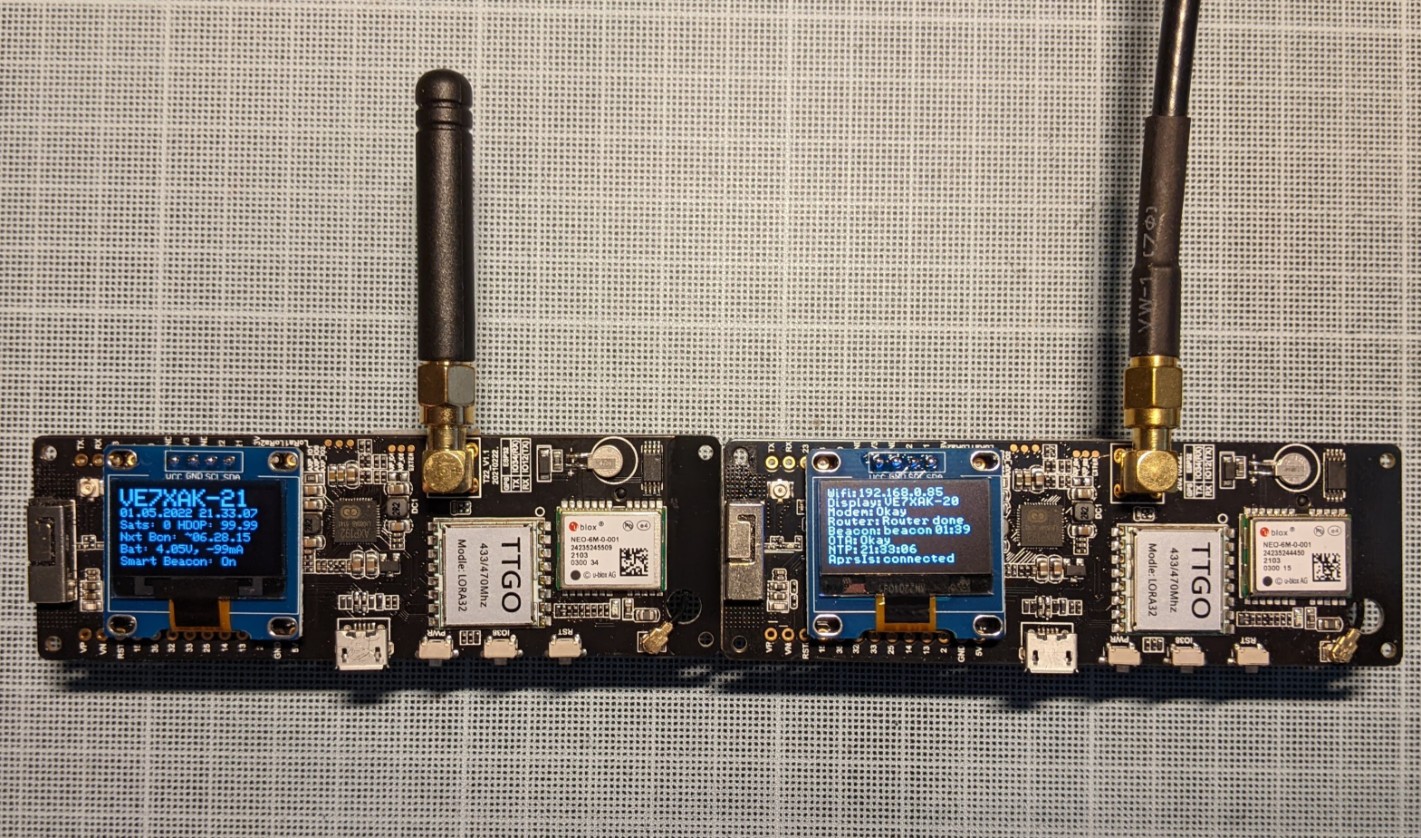
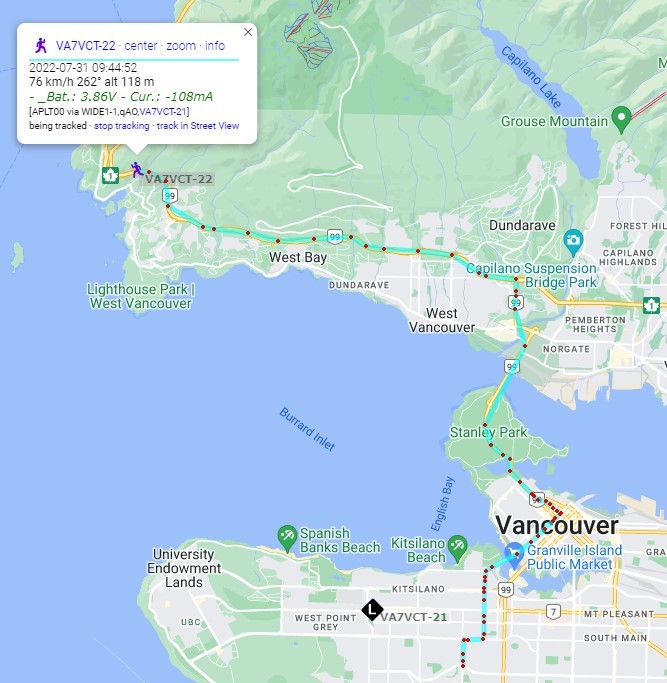
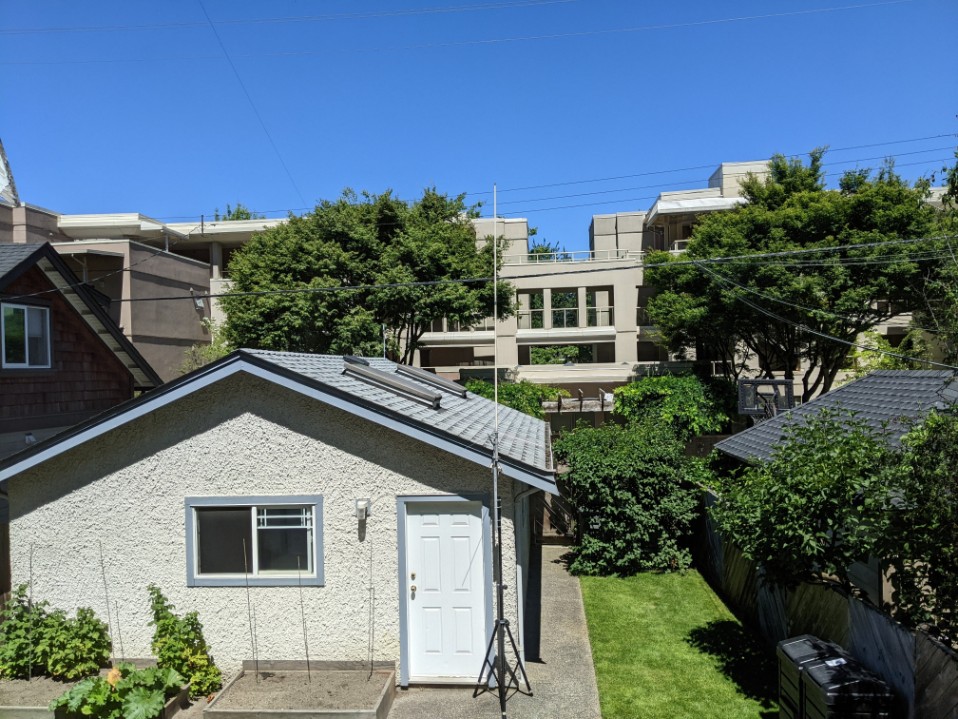
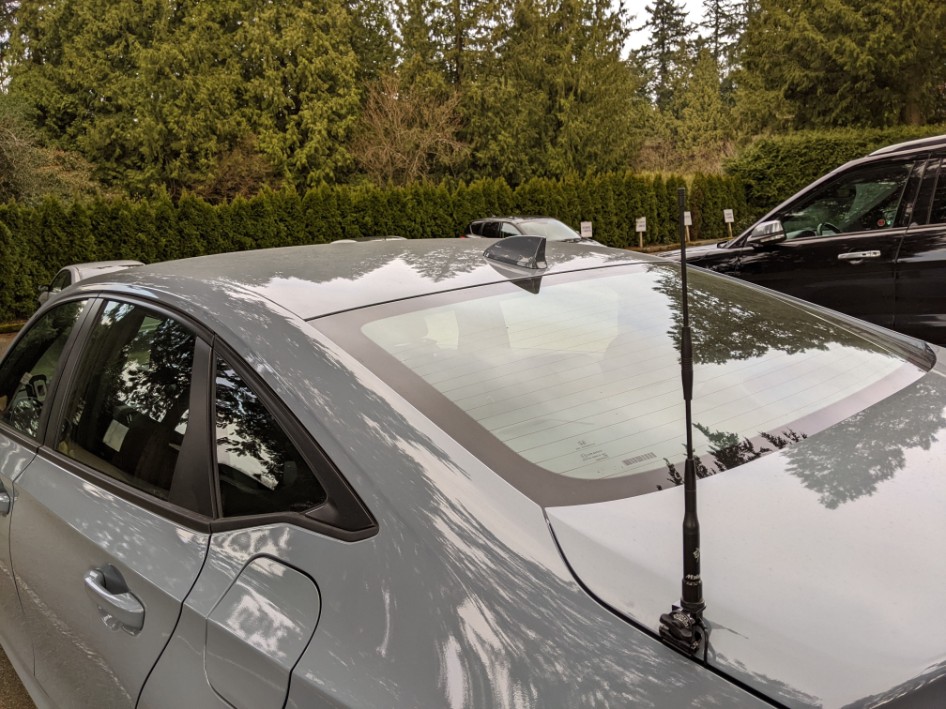
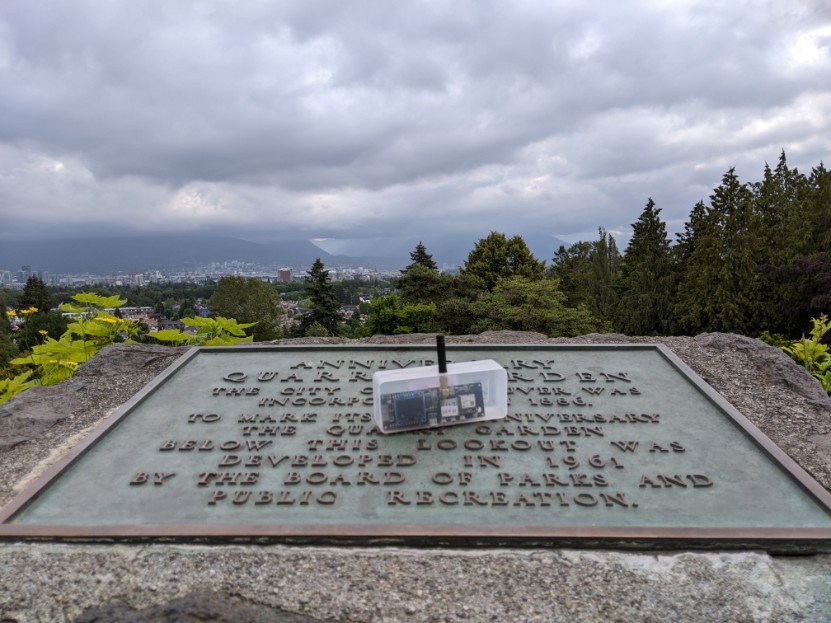
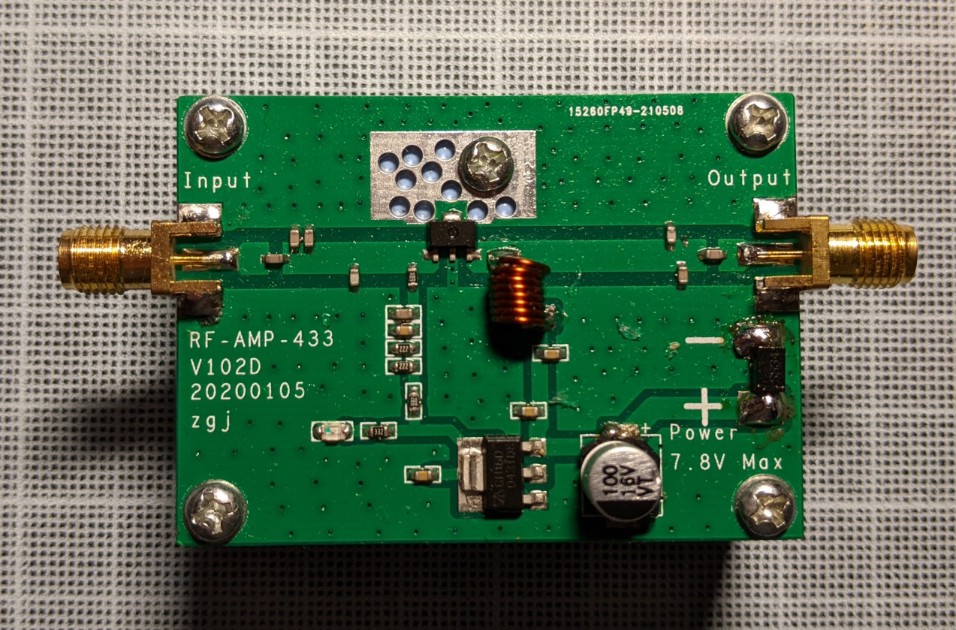
Observations and Thoughts
-
The TTGO T-Beam is a low cost, open source hardware platform that open source developers actively support. During this assessment, two ARPS iGates ran for two months and one Meshtastic node ran for one month (both 24 hours x 7 days) without incident or a need to reboot.
-
There are 433 MHz and 915 MHz versions of T-Beams and people without ham licenses use the latter most commonly in North America. The RF performance is rather limited with the stock transmit power of 0.1 W and the stubby antenna that come with the board. A better antenna, a RF power amplifier, or both, will increase the usable range.
-
For APRS and telemetry use, a LoRa tracker with 1 W output is comparable to a NFM radio at 5 W. Tracking with LoRa is more accurate due to fewer data point losses as a result of the more robust, spread spectrum transmit protocol – compared to a 0.5 second data burst in AX.25, LoRa transmits at a much longer, 3-second burst to convey the data.
-
The T-Beam (or similar LoRa boards) can be deployed quickly to roll out a LoRa based APRS network. It just requires an iGate located at a good vantage point with Internet access, and mobile trackers costing C$80 (including a 18650 Li-ion battery), plus C$40 more for vehicle based trackers with additional RF power amplifier and mobile antenna.
-
Meshtastic is an open source, off grid, GPS mesh communication project. T-Beam is one of the boards supported by Meshtastic. The boards can be setup by anyone with a few easy to follow steps on Meshtastic’s website. Once paired with an Android smart phone with the Meshtastic apps installed, a node is created and ready to send and receive text messages to the other nodes on the same network. The network can totally work off grid.
-
The most important factor affecting the performance of LoRa boards like the T-Beam is RF performance, The on-board LoRa radio module only output 0.1 W max, and the included stubby antenna is useless for anything more than short, line-of-sight communications. A good antenna, and perhaps also a RF power amplifier would definitely help boost the RF performance to meet practical needs from APRS and messaging applications for VECTOR.
-
Based on the RF performance of T-Beams, forming a LoRa network between the E-Comm and the DSA’s with only vertical antennas is feasible - directional antennas are not absolutely necessary, but adding a RF power amplifier at locations like DSA6 might help.
Follow-up Notes and Links
-
Acknowledgments and Thanks
- Norman (VE7NWM) - helped setting up the antenna and hosting the iGate (VA7VCT-21) on the Vancouver west side
- David (VE7ET) - provided tracking data for part of Metro Vancouver
- Anthony (VE7XAK) - planned the evaluation, procured the equipment, analyzed data, and assembled the report
-
Hardware
- 6 TTGO T-Beam ESP32 boards with LoRa, WiFi, Bluetooth Low Energy, GPS, OLED display, 18650 Li-ion power management and Li-ion cell
- configured for 433.775 MHz
- RF power amplifier board to boost RF output of trackers from 0.1 W to 1 W
- roof tripod antenna with feedline for West Side IGate
- vehicle-mounted external antenna for a mobile tracker
-
Firmware - APRS
- iGate: https://github.com/lora-aprs/LoRa_APRS_iGate
- tracker: https://github.com/lora-aprs/LoRa_APRS_Tracker
- utility to reset the GPS: https://github.com/eriktheV-king/TTGO_T-beam_GPS-reset
-
Firmware - Messaging
- Meshtastic Firmware (v1.2.65) is integrated with the flash utility (v1.3.26) from Meshtastic: https://meshtastic.org/docs/getting-started/flashing-firmware/meshtastic-flasher
-
Tools
- Open source firmware from github.com for APRS (IGate and tracker) and messaging services
- Integrated Development Environment such as PlatformIO in Visual Studio Code for flashing and configuring the T-Beams
-
Antenna performance: base and mobile mounted vertical UHF antenna
- 2 x 5/8 λ base antenna for the VA7VCT-21 iGate on Vancouver west side, with limited elevation, reception is not as good as the iGate at E-Comm
- 5/8 λ Mobile Antenna